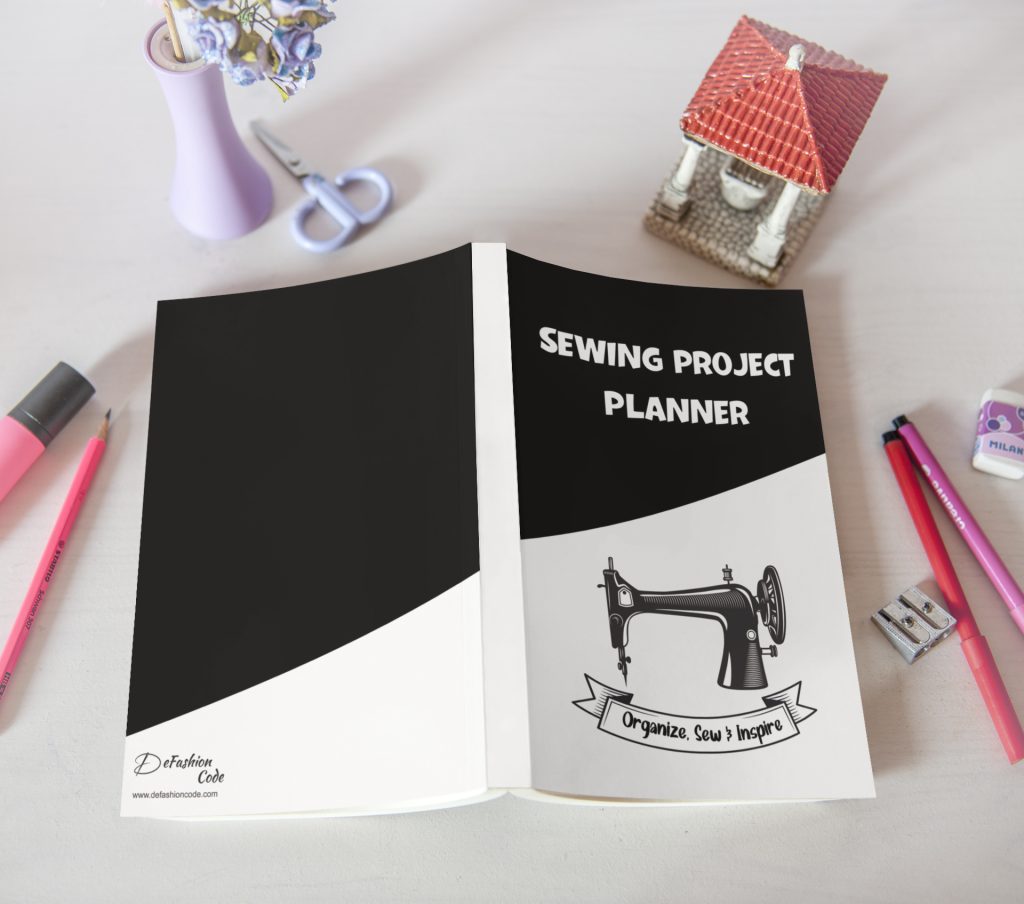If you’re anything like me, you understand the value of note-taking when it comes to our beloved craft. As sewing lovers, we know that capturing important measurements, fabric choices, and project progress is essential for a successful sewing journey. However, with different methods available, such as logbooks and traditional note-taking, it can be perplexing to determine which one is better suited to our needs. In this blog post, we’ll get into the world of sewing note-taking and explore the merits of logbooks versus traditional methods. By examining their benefits and drawbacks, we aim to find the perfect fit for our individual sewing styles and preferences.
Logbooks for Sewing

When it comes to note-taking in sewing, logbooks offer a unique and structured approach. Let’s take a closer look at the benefits and practical aspects of using logbooks for your sewing projects.
Advantages of Using Logbooks:
1.Organization and Categorization
Logbooks provide a systematic way to organize your sewing projects, keeping everything in one place. You can categorize your projects based on different criteria, such as project type (garments, accessories, home decor), season, or skill level. With a well-maintained logbook, you can easily locate specific projects and reference past work.
2. Tracking Progress and Improvements
With a logbook, you can record details about each project’s progress, including dates, milestones, and techniques used. Tracking your progress over time allows you to see how your skills have developed and provides motivation for future projects. By noting challenges faced and solutions discovered, you can learn from your experiences and make improvements in future sewing endeavors.
3. Documentation of Fabric Choices, Measurements & Patterns
Logbooks serve as a repository for fabric swatches, including details like fabric type, weight, and source, making it easier to reference for future projects. You can record measurements, alterations, and adjustments made for each project, ensuring consistency in sizing and fit. Logbooks also provide a space to document patterns used, including any modifications or pattern sources.
4. Examples and Templates
Numerous examples and templates are available online to help you get started with your own sewing logbook. Some logbooks may include dedicated sections for sketches, project notes, or even inspirational images. Explore different logbook formats, such as printable templates or digital versions, to find the one that resonates with your organizational style.
Disadvantage of Log Books:
1. Lack of Flexibility:
One potential drawback of using logbooks for note-taking in sewing is the limited flexibility they offer. Logbooks often come with pre-determined sections and formats, which may not align perfectly with your specific note-taking needs or preferred organizational style. Customizing or deviating from the established structure may be challenging, restricting your ability to tailor the note-taking experience to your unique preferences.
2. Portability Concerns:
Another disadvantage of logbook note-taking is related to portability. Physical logbooks can be bulkier and less convenient to carry around compared to digital alternatives or traditional handwritten notes. If you frequently sew on the go or prefer to have your notes readily accessible wherever you are, the size and weight of a logbook may pose practical limitations.
3.Integration with Other Sewing Resources
Traditional note-taking seamlessly integrates with other sewing resources. As you dive into books, magazines, or online tutorials, you can easily jot down valuable insights and tips directly into your notes. By combining your personal observations with external sources, you create a comprehensive and personalized knowledge base. Cross-referencing your notes with external resources helps you easily retrieve additional information or find inspiration whenever needed.
Practical Tips for Effective Logbook Note-taking:

-Enhance your logbook by incorporating visual elements such as fabric swatches, sketches, or photographs. .
-Use your logbook as a tool for reflection and learning. Take the time to review your past entries, identify patterns or trends, and make notes on lessons learned or areas for improvement.
-Take measures to protect your logbook from damage or loss, store it in a safe place and make backup copies if using digital logbooks.
Traditional Note-taking for Sewing

Ah, the world of traditional note-taking! For those of us who appreciate the freedom of customization and the tactile experience of pen and paper, traditional methods offer a whole new level of flexibility in our sewing endeavors.
Advantages of using traditional note-taking:
1.Handwritten Notes adds a Personal Touch
There’s something special about putting pen to paper and jotting down our sewing notes. Handwritten notes allow us to infuse our personality into our projects and establish an immediate connection. We can capture measurements, fabric details, and project insights in a format that feels comfortable and familiar. Plus, who can resist the joy of flipping through a beautifully filled notebook?
2.Flexibility and Customization
One of the main advantages of traditional note-taking is the flexibility it offers. You have the freedom to structure your notes in a way that suits your personal preferences. Whether you prefer the classic notebook approach, index cards, or creating your own templates, the choice is yours. Customize your note-taking style to focus on what matters most to you, such as tracking fabric stash, documenting pattern modifications, or recording sewing techniques that inspire you.
3.Integration with Other Sewing Resources
Traditional note-taking seamlessly integrates with other sewing resources. As you dive into books, magazines, or online tutorials, you can easily jot down valuable insights and tips directly into your notes. By combining your personal observations with external sources, you create a comprehensive and personalized knowledge base. Cross-referencing your notes with external resources helps you easily retrieve additional information or find inspiration whenever needed.
Disadvantages of Traditional Note-taking:
1. Organization Challenges:
Traditional note-taking methods, such as using notebooks or index cards, can present challenges when it comes to organization. Without a predefined structure, it may be more difficult to categorize and locate specific sewing notes or reference information. Without clear labels or tags, finding and retrieving relevant details from a collection of handwritten notes can become time-consuming and inefficient.
2. Risk of Loss or Damage:
Handwritten notes are susceptible to loss or damage. If a notebook or individual note is misplaced, damaged, or destroyed, valuable sewing information may be irretrievably lost. Accidental spills, tears, or misplacement of physical notes can result in the loss of measurements, fabric swatches, or project details. Unlike digital alternatives, traditional notes lack the automatic backup and easy duplication options that can safeguard your valuable sewing information.
3. Limited Searchability:
Traditional note-taking methods generally lack the searchability that digital note-taking offers. When relying on handwritten notes, finding specific information requires manually flipping through pages or scanning through stacks of notes. This lack of quick search functionality can be a hindrance when you need to locate specific sewing techniques, measurements, or patterns, especially when working on complex or time-sensitive projects.
Practical Tips for Effective Traditional Note-taking

To make the most of traditional note-taking in your sewing journey, keep these practical tips in mind:
– Keep your notes organized with clear headings, labels, or tags for easy navigation.
– Regularly review and update your notes to ensure accuracy and relevance.
– Experiment with different note-taking tools, pens, or digital apps to find the ones that feel most comfortable and conducive to your creativity.
-Take measures to protect your notes from damage or loss.
Comparing Logbooks and Traditional Note-taking

Now that we have explored the advantages and disadvantages of both logbooks and traditional note-taking, let’s do some short comparisons of the two methods to determine which is better suited for sewing enthusiasts.
Organization and Categorization Features
Logbooks excel in providing a structured and organized approach to note-taking, with pre-determined sections and categories. On the other hand, traditional note-taking allows for more flexibility in structuring and categorizing notes based on personal preferences.
Tracking Progress and Improvements
Both logbooks and traditional note-taking methods allow for tracking project progress and improvements. Logbooks offer a systematic approach to record milestones and techniques used, while traditional note-taking allows for more personalized and detailed documentation of progress and learning experiences.
Documentation Capabilities for Fabric Choices, Measurements & Patterns
Logbooks provide dedicated sections for fabric details, measurements, and pattern documentation, making it easy to refer back to essential information. Traditional note-taking methods can also document these elements, but the format and organization may vary depending on personal preference and note-taking style.
Personal Preferences and Sewing Styles
Ultimately, the choice between logbooks and traditional note-taking methods depends on personal preferences and individual sewing styles. Some may prefer the structured approach and organization of logbooks, while others thrive on the flexibility and customization of traditional note-taking. It’s important to consider what works best for you and enhances your sewing experience.
Which Method is Better for Sewing?

While it’s tempting to declare one method as the clear winner, the truth is that there is no one-size-fits-all answer. Both logbooks and traditional note-taking methods offer unique advantages and cater to different needs. The better method for sewing ultimately depends on your personal preferences, organizational style, and the level of customization you desire.
As you embark on your sewing journey, take the time to experiment with different note-taking methods and find the one that resonates with you. Whether you choose the structured approach of logbooks or the freedom of traditional note-taking, what truly matters is capturing and preserving the joy, creativity, and knowledge that sewing brings to your life.
So, embrace the art of note-taking in your sewing, and let your chosen method be the trusted companion that helps you create, learn, and flourish in your sewing endeavors.
But wait, there’s more!
If you’re thinking about using log books, you should definitely check out Defashion Code’s sewing log books. They are specially designed to boost and inspire sewers like you! And if you prefer taking notes the traditional way, we have notebooks that are perfect for you too!
Defashion Code Log books include:
- Table of Contents
- Project Name
- Start Date, End Date
- Client Information (Name, Phone Number, Email, Address)
- Sewing Inspirational Quotes
- Project Description
- Measurements
- Materials
- Setup (Machine, Thread, Needle, etc.)
- Sketch
- Notes
- Billing (Project Cost)
- Project Difficulty Rating
Whether you’re a beginner or a seasoned seamstress, our books will become your trusted companion on your sewing journey. Happy stitching!



